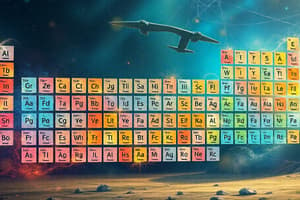Podcast
Questions and Answers
Which of the following materials typically exhibit metallic luster and can conduct heat and electricity?
Which of the following materials typically exhibit metallic luster and can conduct heat and electricity?
- Steel, copper, brass (correct)
- Plastics, solvents, lubricants
- Graphite, sulfur, oxygen
- Carbon, hydrogen, nitrogen
What distinguishes nonmetals from metals in terms of their ability to react with acids?
What distinguishes nonmetals from metals in terms of their ability to react with acids?
- Form strong bonds with acids
- Readily react with acids
- React quickly but mildly with acids
- Do not react with acids (correct)
Which property differentiates nonmetals from metals based on density?
Which property differentiates nonmetals from metals based on density?
- Nonmetals are heavier than water (correct)
- Metals are lighter than nonmetals
- Nonmetals are denser than metals
- Metals are less dense than water
In which task are nonmetals like carbon, hydrogen, and oxygen particularly crucial?
In which task are nonmetals like carbon, hydrogen, and oxygen particularly crucial?
What distinguishes nonmetals from metals in terms of their physical properties?
What distinguishes nonmetals from metals in terms of their physical properties?
What role does oxygen, a nonmetal element, play in living creatures?
What role does oxygen, a nonmetal element, play in living creatures?
What is the main characteristic that distinguishes metals from nonmetals?
What is the main characteristic that distinguishes metals from nonmetals?
Which physical attribute allows malleable metals to be shaped easily?
Which physical attribute allows malleable metals to be shaped easily?
What property refers to the ability of metals to be drawn out into thin wires?
What property refers to the ability of metals to be drawn out into thin wires?
Which of the following is NOT a common example of a metal?
Which of the following is NOT a common example of a metal?
What type of metals can be alloyed with other materials to create compounds like metal composites?
What type of metals can be alloyed with other materials to create compounds like metal composites?
Besides their intrinsic qualities, what other function do metals serve according to the text?
Besides their intrinsic qualities, what other function do metals serve according to the text?
Flashcards are hidden until you start studying
Study Notes
Science: Studying Metals and Nonmetals
Science is a broad field encompassing various disciplines, one of which is chemistry. Within chemistry, there are two main categories of elements: metals and nonmetals. These classes of elements have distinct properties that make them valuable resources for numerous applications across different industries. Let's delve into these categories further to understand their characteristics and significance.
Metals
Metals are chemical elements characterized by their ability to conduct heat and electricity. They often appear shiny when polished due to their reflective nature. Some common examples of metals include aluminum, copper, gold, iron, lead, silver, tin, zinc, and many more. Metals can exist both in pure form and alloyed with other materials such as ceramics or plastics to create compounds like metal composites.
The physical attributes of metals vary according to their purity level. Highly refined metals exhibit malleability, ductility, and tensile strength. Malleable metals can be hammered into various shapes without breaking easily; ductile metals can be drawn out into thin wires without shattering; and tensile strength refers to how much weight they can support before being stretched apart. However, even though some metals may look similar under specific conditions, they actually behave quite differently from each other.
In addition to their intrinsic qualities, metals serve several practical functions. For instance, they play crucial roles in building construction, automobile manufacturing, industrial machinery production, and electronics fabrication. Furthermore, metals like steel, copper, brass, bronze, pewter, etc., find extensive usage in day-to-day life items such as knives, cutlery, jewelry, ships, railways, guns, musical instruments, locksmith equipment, tools, coins, and medals.
Nonmetals
Nonmetals, on the other hand, do not possess metallic luster and cannot conduct heat or electricity. Instead, they tend to be dull and opaque. Common nonmetal elements include carbon, hydrogen, oxygen, nitrogen, phosphorus, sulfur, selenium, tellurium, and radon. Although most nonmetals are solids at room temperature, they can evaporate when heated sufficiently.
Unlike metals, which we typically think of as hard, durable substances, most nonmetallic solids are brittle and prone to fracture upon impact. One distinguishing characteristic of nonmetals is that they don't react readily with acids. While some nonmetals might show a potential reaction if placed in strong acid solutions, it would usually take hours for any visible change to occur. Another notable difference between metals and nonmetals lies in their density—nonmetals generally weigh less than water while metals are denser.
Despite having fewer uses compared to metals, some nonmetal elements still contribute significantly to society through technological advancements and everyday products. Carbon, for example, serves as the foundation of organic molecules found in living organisms and is integral to plastics and graphite. Hydrogen plays critical roles in energy storage systems because of its high combustion rate. Oxygen, another key component of air, supports respiration processes in living creatures. Nitrogen is used extensively in fertilizers and explosives. Additionally, nonmetals represent essential ingredients in certain pharmaceuticals, detergents, lubricants, paints, solvents, and soaps.
Significance and Applications
Understanding the differences between metals and nonmetals helps us appreciate their unique properties and exploit those properties effectively. When combined together in a compound state, their disparities interact synergistically to produce exceptional results. This interplay between metals and nonmetals creates an expanded range of possibilities for human innovation and progress.
From structural integrity to electronic communication, from medical treatments to cosmetic enhancements, our daily lives depend heavily on materials whose origins trace back to this basic classification of elements. Therefore, studying science—particularly chemistry—and gaining insights into these fundamentals remains instrumental in driving scientific discovery and advancing humanity forward.
Studying That Suits You
Use AI to generate personalized quizzes and flashcards to suit your learning preferences.




